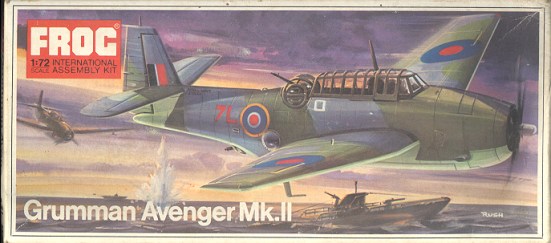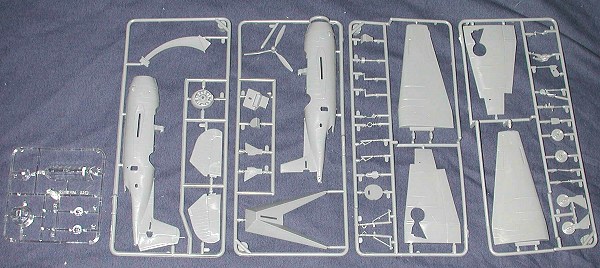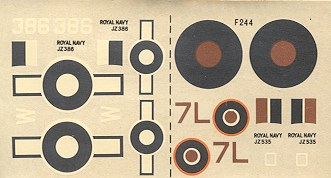
|
KIT: |
Frog 1/72 Avenger II |
|
KIT # |
F 244 |
|
PRICE: |
Long out of production |
|
DECALS: |
Two options |
|
REVIEWER: |
Scott Van Aken |
|
NOTES: |

|
HISTORY |
On December 7, 1941, Japanese aircraft tore through the skies of Pearl Harbor in an attack on the US Pacific Fleet—thus drawing the United States into the throes of World War II. This was a war that would see over fifty million people lose their lives and a world forever changed. In the early days of this war, an aircraft emerged as one of the most important and useful in America’s arsenal—the TBM. Nicknamed the Avenger, to avenge the attack at Pearl Harbor, the TBM was a key player since the Battle of Midway in every carrier versus carrier battle in the Pacific. Whether thundering off the deck of American or British Carriers, or roaring out of Henderson field on Guadalcanal, the TBM’s were key in the delivery of devastating blows to the Japanese military.
The TBM replaced the TBD Devastator after the TBDs were decimated at Midway in 1942. Able to carry a prodigious load and with improved defensive armament, the Avenger was the US Navy's main torpedo bomber and was responsible for helping to send a considerable tonnage of enemy shipping to the bottom of the ocean. The type was also used by the Royal Navy, who initially called it the Tarpon, but reverted to Avenger to keep from confusion when operating with US TBMs. So rugged and useful was the Avenger, that it spawned several other variants post-war, including a radar carrying variant used in hunter/killer operations and as the Navy's first AEW aircraft. Many were sold to overseas forces and were used until the 1960s. Its ability to carry a large useful load also found them in demand as fire bombers and most of the Avengers on the air show circuit have spent part of their lives putting out fires.
|
THE KIT |

When I was into my 'second wind' of model building in the early/mid 1970s, one of the kits I bought and built a lot of were Frog kits. Back then, I was much more interested in ease of construction and cool markings than I was on detail (whoa, sorta sounds like me now!). The result was that I had a lot of cool looking (to me), brush painted Frog kits. Most of those have sadly gone the way of the parts or trash bin over the decades, but I still like Frog kits.
Most are like this one. It has raised detail, the ability to build the kit with the wheels up and a display stand. There is little cockpit detail, only a floor, seat, stick and pilot. No instrument panel or sidewall detail or even a decal for the instruments. The wheels are attached to the axles by heating the end to keep them from falling off. The turret is really more of a thimble shaped piece than what is provided by someone like, say, Accurate Miniatures. However, it is better than the one that Airfix supplied as you could actually make this one rotate without a lot of fuss and trimming. Those familiar with RN Avengers (which were initially called Tarpons) is that the aft side windows were bubble shaped rather than just flat. This was so the observer could have better vision to the bottom of the plane while looking for subs or whatever other target they were seeking.
 Frog
was also one of the first companies to introduce the all pictorial
instruction sheet. Thanks to the minimal number of parts in this kit (at
least compared to the Hasegawa kit), construction is pretty rapid as one
goes through the 8 construction steps. Color info (where required) is
provided via generic names through the building process. Overall camo and
markings are on the back of the box and in full color. Both options are
in Dark Slate Grey/Extra Dark Sea Grey over Sky. The box art aircraft is
from 857 Sq in Scotland during August 1944. The other option is also from
857 Sq but with SEA roundels as used by the British in the Pacific during
mid 1945. The decals themselves are semi-matte and have survived rather
well over the years. Generally, they work well and anyone buying an
ancient Frog kit like this would be well served by either aftermarket
decals or recoating the ones that are there to keep them from dissolving.
Frog
was also one of the first companies to introduce the all pictorial
instruction sheet. Thanks to the minimal number of parts in this kit (at
least compared to the Hasegawa kit), construction is pretty rapid as one
goes through the 8 construction steps. Color info (where required) is
provided via generic names through the building process. Overall camo and
markings are on the back of the box and in full color. Both options are
in Dark Slate Grey/Extra Dark Sea Grey over Sky. The box art aircraft is
from 857 Sq in Scotland during August 1944. The other option is also from
857 Sq but with SEA roundels as used by the British in the Pacific during
mid 1945. The decals themselves are semi-matte and have survived rather
well over the years. Generally, they work well and anyone buying an
ancient Frog kit like this would be well served by either aftermarket
decals or recoating the ones that are there to keep them from dissolving.
|
CONCLUSIONS |
If you are looking for a pleasant build and not having to pay a lot for it, I'd suggest these older Frog kits. They can usually be found for less than $5 at swap meets and other than possibly having unusable decals, make into decent shelf models. They are also great for the younger modeler who doesn't want to fuss with all sorts of small parts.
If you would like your product reviewed fairly and quickly by a site that has over 250,000 visitors a month, please contact me or see other details in the Note to Contributors.